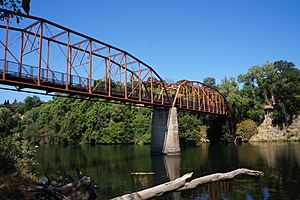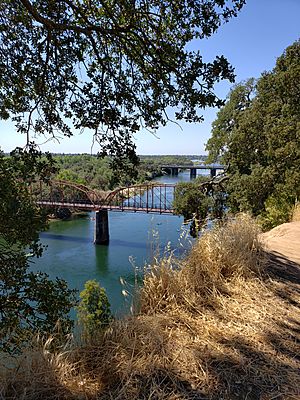Fair Oaks Bridge facts for kids
Quick facts for kids Fair Oaks Bridge |
|
|---|---|
 |
|
| Coordinates | 38°38′11″N 121°15′54″W / 38.636271°N 121.265109°W |
| Crosses | American River |
| Locale | Sacramento, California, United States |
| Official name | Fair Oaks Bridge |
| Named for | Fair Oaks, California |
| Characteristics | |
| Design | Pennsylvania Truss bridge |
| History | |
| Constructed by | Western Bridge and Construction Company |
| Lua error in Module:Location_map at line 420: attempt to index field 'wikibase' (a nil value). | |
The Fair Oaks Bridge is a special type of truss bridge that crosses the American River. It connects the town of Fair Oaks to the larger Sacramento, California area. The bridge you see today was built between 1907 and 1909. It cost about $63,000 back then. This is actually the third bridge to stand in this exact spot!
The very first bridge opened in 1901. It helped Fair Oaks grow from a small farming area into a busy place for agriculture. The current bridge, built a few years later, helped Fair Oaks become a popular place for people who worked in Sacramento to live by the 1940s. Today, the Fair Oaks Bridge is only used by people walking or riding bikes.
Contents
History of the Fair Oaks Bridge
How Fair Oaks Started
In 1895, two businessmen from Chicago, Charles Henry Howard and James W. Wilson, bought land in California. They wanted to sell this land and create new communities. They called their projects "Sunset Colonies." Fair Oaks was one of these.
They advertised Fair Oaks as a great place to grow citrus fruits. This was especially appealing after bad freezes hit fruit farms in other parts of the U.S. Many people who bought land were professionals like bankers and engineers.
By 1897, about 300 people lived in Fair Oaks. They bought land in different sizes, hoping to grow fruit. Most of them didn't have much farming experience. They were excited because they were promised a bridge over the American River. This bridge would help them get their fruit to markets in Sacramento and beyond.
However, by the next year, the company that started Fair Oaks left. The promises of a bridge and a railroad connection from Sacramento were not kept.
Building the First Bridge
In 1899, some businessmen who had invested in Fair Oaks and Orangevale formed a group called the Chicago-Fair Oaks Club. Local businessmen also created the Fair Oaks Development Company in 1900. One of these was Valentine S. McClatchy, who owned The Sacramento Bee newspaper.
These groups worked together to promote Fair Oaks. In 1901, they convinced Sacramento County to build a bridge across the American River at Fair Oaks. They also persuaded the Southern Pacific Rail Road Company to build a train track to the bridge.
That summer, the train track and a station were built. The station was called Fair Oaks Bridge Depot. This train connection helped farmers in Fair Oaks sell their fresh fruit to many places.
The Three Bridges of Fair Oaks
Fair Oaks grew quickly after the first bridge and railroad line were completed. But in March 1907, a big flood washed away this first Fair Oaks Bridge.
After the flood, a long steel cable was used with a ferry boat to cross the river. Sacramento County also approved building a temporary bridge. The Sacramento Chamber of Commerce decided to help rebuild a permanent bridge.
By the end of 1907, the Western Bridge and Construction Company from Omaha, Nebraska began building the double truss bridge that we still see today. This bridge is very important because of its history and design. It was added to the National Register of Historic Places in September 2006. This means it's recognized as a special historical site.
Over time, new bridges were built nearby. The Watt Avenue bridge opened in 1959, and the Hazel Avenue bridge opened in 1967. The Sunrise Bridge, which is very close, was also made wider in 1968. These new bridges made the Fair Oaks Bridge less important for cars.
In 1967, the Fair Oaks Bridge was closed to traffic. It became the property of the Sacramento County Parks and Recreation Department. After serving for over 50 years as a main crossing, it was given a new purpose. In 1973, the bridge was repaired and painted. It then reopened as a path for walkers and cyclists. It now connects to the American River Parkway Trail.
Bridge Structure and Design
The Fair Oaks Bridge is a great example of how bridges were built in the late 1800s and early 1900s. It's a special type called a Pennsylvania Petit through Pratt truss bridge. It stretches almost 500 feet (150 m) across a wide part of the American River.
This bridge is the second oldest of its kind still standing in California. The oldest is a historic truss bridge in Folsom, built in 1893. The designers wanted to use as few support piers as possible in the river's strong current. The Pennsylvania Petit design was perfect for this, allowing for very long main sections. The two 200 ft sections were quite daring for their time. This bridge is also a rare example of work by the Western Bridge and Construction Company in California.
What is a Truss Bridge?
A truss bridge is a bridge where the parts are connected in a triangular pattern. Think of triangles making up the sides of the bridge. Truss bridges have been around for a long time, since at least the 1500s. However, metal truss bridges, like the Fair Oaks Bridge, only started being built in the 1840s.
These metal truss bridges, especially the Pratt and Warren types, were very important. They helped build many railroad lines in the late 1800s. They were also key for building highways around the turn of the century.
The triangular trusses form the vertical sides of the bridge. These sides are connected by beams that go across, and by other parts that hold up the bridge deck (where you walk or drive). Every truss bridge has a top and bottom "chord." These are the main beams that handle the stress on the bridge. The top and bottom chords are connected by vertical or diagonal pieces, or both. There are also strong beams at each end called endposts.
Pratt Truss Design
The Pratt truss design was invented in 1844 by Thomas and Caleb Pratt. It's the most common type of truss bridge in California and the United States.
At first, this design was used for "combination trusses." These bridges were made of both wood and iron. They had wooden vertical parts, chords, and endposts, but iron diagonal pieces that were under tension (being pulled).
By the 1880s, the design changed to be all metal. It still used light metal diagonal pieces. But it replaced the wooden parts with heavier metal beams, posts, and chords. The most common Pratt type is the "through truss." This means the bridge deck is carried on the lower chord, and there are supports overhead connecting the top chords.
Finally, the Pennsylvania Petit is a specific type of Pratt truss. It has a top chord that is shaped like a polygon (many sides). It also includes extra smaller supports and ties. These half-length pieces help make the diagonals stronger and resist stress.
Summary of the Fair Oaks Bridge
The Fair Oaks Bridge you see today is the third bridge to cross the American River in this spot. It connects Fair Oaks to the wider Sacramento area. It used to be a very important crossing for cars. However, new bridges built in the 1950s and 1960s, like those at Sunrise and Hazel, took over its role.
Even so, the bridge is still very useful. It's now a popular path for people who enjoy walking and biking. It's also an important local landmark. On September 25, 2006, the Old Fair Oaks Bridge was officially listed as a National Historic Site. This means it's recognized for its important history and its special architectural design.



